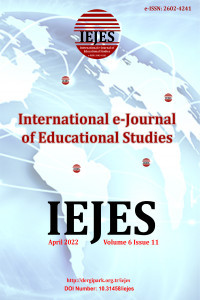Perceptions of the Effect of Digital Literacy Levels of who Take Sports Education Students on E-Learning
Digital literacy, e-learning, sport studens, physical education
Perceptions of the Effect of Digital Literacy Levels of who Take Sports Education Students on E-Learning
Digital literacy, e-learning, sport studens, physical education,
___
- Aksoy, N. C., Karabay, E., & Aksoy, E. (2021). Sınıf öğretmenlerinin dijital okuryazarlık düzeylerinin incelenmesi [Examining the digital literacy levels of classroom teachers] Selçuk İletişim, 14(2), 859-894. https://doi.org/10.18094/josc.871290
- Al Rawashdeh, A. Z., Mohammed, E. Y., Al Arab, A. R., Alara, M., & Al-Rawashdeh, B. (2021). Advantages and disadvantages of using e-learning in university education: Analyzing students’ perspectives. Electronic Journal of E-learning, 19(3), 107-117.
- Alshammari, R. H. (2019). E-learning implementation, adoption and success: A socio-technical review. Education and Information Technologies, 24(3), 2201-2225.
- Arkorful, V., & Abaidoo, N., (2015). The role of e-learning, advantages and disadvantages of its adoption in higher education. International Journal of Instructional Technology and Distance Learning, 12(1), 29-42
- Bay, D. N. (2021). Digital literacy levels of preschool teacher candidates. Mustafa Kemal Üniversitesi Eğitim Fakültesi Dergisi, 5(7), 172-187.
- Fortuna, C. (2015). Digital media literacy in a sports, popular culture and literature course. Journal of Media Literacy Education, 6(3), 81-89.
- Fraillon, J., Ainley, J., Schulz, W., Friedman, T., & Duckworth, D. (2020). IEA International Computer and Information Literacy Study 2018. Technical Report. International Association for the Evaluation of Educational Achievement.
- Gautam, S. S., & Tiwari, M. K., (2016). Components and benefits of e-learning system. International Research Journal of Computer Science (IRJCS), 3(1), 14-17
- Gilster, P., & Glister, P. (1997). Digital literacy (p. 1). NY: Wiley Computer Pub.
- Gökbulut, B. (2021). Examining teachers’ digital literacy levels and lifelong learning tendencies. Yükseköğretim ve Bilim Dergisi, 11(3), 469-479.
- Göldağ, B. (2021). Examining the relationship between university students’ digital literacy levels and digital data security awareness levels. E-International Journal of Educational Research, 12(3).
- Göldağ, Ö. Ü. B., & Kanat, Ö. Ü. S. (2018). Digital literacy status of students studying fine arts. The Journal of Academic Social Science Studies, 70, 77-92. http://doi.org/10.9761/JASSS7736
- Huang, Y. M., & Chiu, P. S., (2015). The effectiveness of a meaningful learning‐based evaluation model for context‐aware mobile learning. British Journal of Educational Technology, 46(2), 437-447. https://doi.org/10.1111/bjet.12147
- Islam, N., Beer, M., & Slack, F., (2015). E-learning challenges faced by academics in higher education. Journal of Education and Training Studies, 3(5), 102-112.
- Jones, C., Ramanau, R., Cross, S., & Healing, G. (2010). Net generation or digital natives: Is there a distinct new generation entering university?. Computers & Education, 54(3), 722-732.
- Joshua, D., Obille, K., John, E., & Shuaibu, U., (2016). E-Learning platform system for the department of library and information science, Modibbo Adama University of Technology, Yola: A developmental plan. Journal of Information and Knowledge Management, 7(1), 51-69.
- Karakuş, G., & Ocak, G. (2019). Examining the digital literacy self-efficacy skills of teacher candidates in terms of different variables Afyon Kocatepe Üniversitesi Sosyal Bilimler Dergisi, 21(1), 129-147. https://doi.org/10.32709/akusosbil.466549
- Keegan, D. (2013). Foundations of distance education. Routledge, Dublin.
- Kozan, M., & Özek, M. B. (2019). Examination of CEIT department teacher candidates’ digital literacy levels and sensitivity towards cyberbullying. Fırat Üniversitesi Sosyal Bilimler Dergisi, 29(1), 107-120. https://doi.org/10.18069/firatsbed.538657
- Öztürk, M. (2023). Dijital okuryazarlık ve internet reklamcılığı. İstanbul: Literatürk Academia.
- Prensky, M. (2001). Digital natives, digital immigrants part 1. On the Horizon, 9(5), 1-6.
- Qazi, A., Hasan, N., Abayomi-Alli, O., Hardaker, G., Scherer, R., Sarker, Y., ... & Maitama, J. Z. (2022). Gender differences in information and communication technology use & skills: a systematic review and meta-analysis. Education and Information Technologies, 1-34.
- Raspopovic, M., Cvetanovic, S., Medan, I., & Ljubojevic, D.,2017. The effects ofintegrating social learning environment with online learning. The International Review of Research in Open and Distributed Learning, 18(1), 141-160. https://doi.org/10.19173/irrodl.v18i1.2645
- Raice, M. F., & Bailon, M. (2023). A qualitative analysis of publicly available standards and guidance about digital literacies in US States. Education and Information Technologies, 28(6), 6927-6946. https://doi.org/10.1007/s10639-022-11482-x
- Rosell-Aguilar, F. (2020). State-of-the-art review of research on mobile language learning. Language Learning & Technology, 24(1), 1-24.
- Sönmez, V. & Alacapınar, F. G,, (2011). Örneklendirilmiş bilimsel araştırma yöntemleri [Exemplified scientific research methods]. Ankara: Anı Yayınları.
- Şahin, A. (2021). Examining the digital literacy levels of religious culture and ethics teacher candidates and their attitudes towards e-learning İnsan ve Toplum Bilimleri Araştırmaları Dergisi, 10(4), 3496-3525. https://doi.org/10.15869/itobiad.937532
- Tabachnick, B. G, & Fidell. L. S. (2007) Using multivariate statistics. Allyn & Bacon/Pearson Edu.
- Başlangıç: 2017
- Yayıncı: Tamer KUTLUCA
An Ontological Study on Proof: If and only If Propositions
Development of Turkish Reading Anxiety Scale
Suleyman KASAP, Mahmut AYAZ, Mehmet Sena ATAŞ
An Analysis of the Place of the History of Science in Chemistry Textbooks
Gülşah ZERMAN KEPCEOĞLU, Serhat İREZ
Sustainability and its Reflection on Education
Oğuzhan ALTUNGÜL, Didem YAVUZ SÖYLER, Mesut BULUT
Cognitive and Metacognitive Strategies in Problem-Posing Tasks in the Context of Science
Gülfem Dilek YURTTAŞ KUMLU, Mehtap TAŞTEPE
Examination of Foreign Students’ Anxiety in Learning Turkish in Terms of Various Variables
